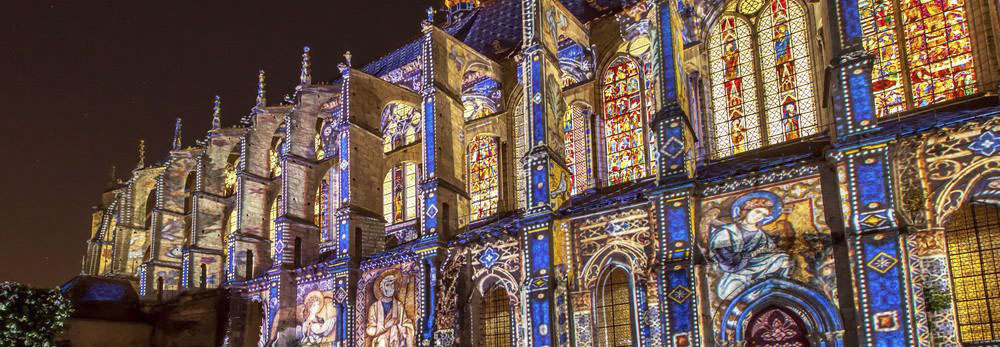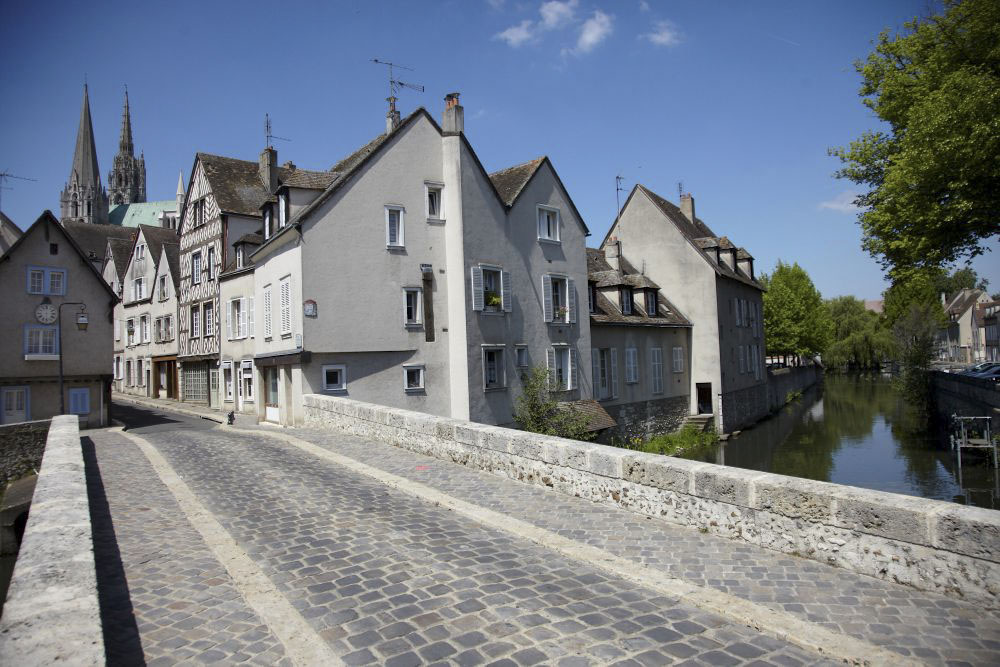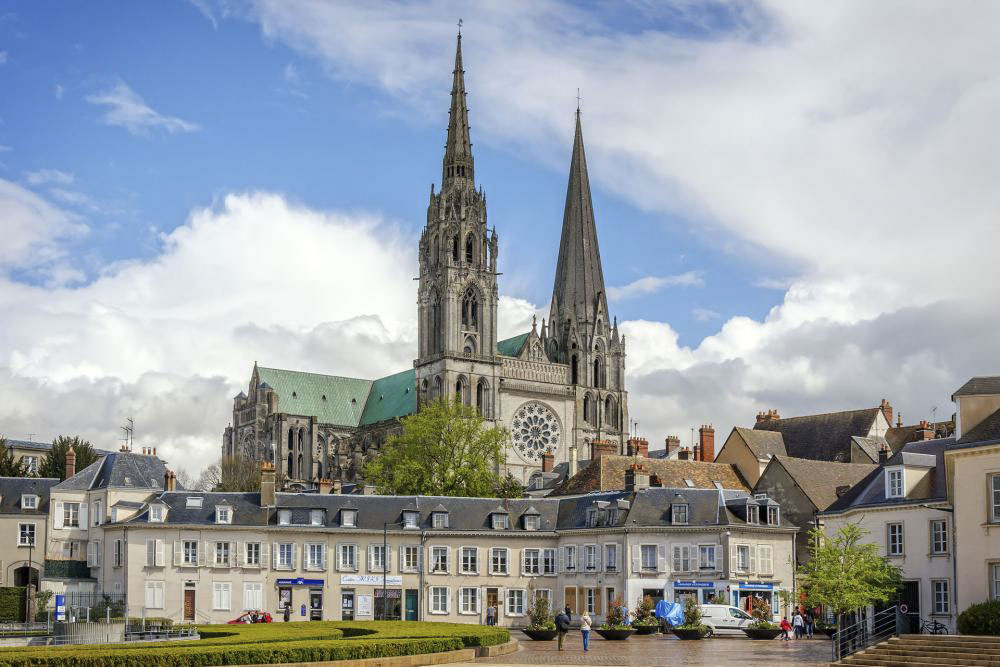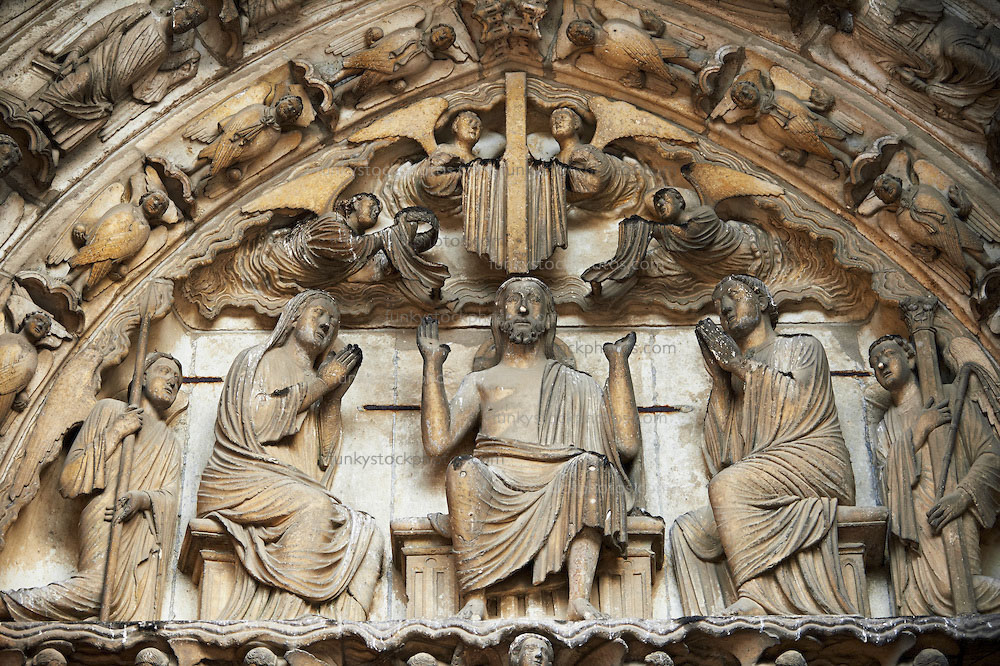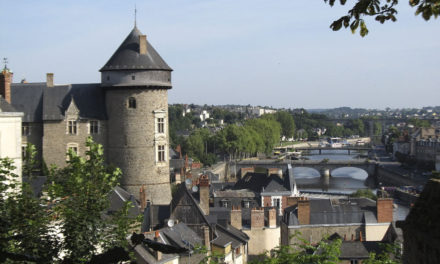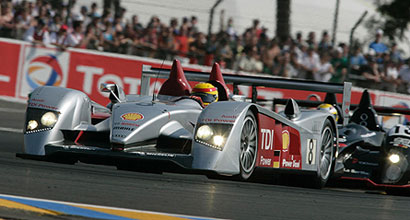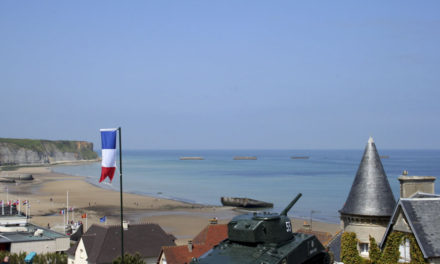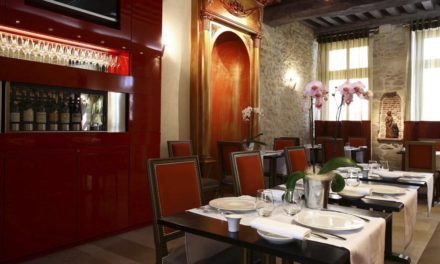Chartres is the capital of the Eure-et-Loir department in the Loire Valley region of northern France. Located 78 km from Paris and 280 km from the port of Calais, it is a popular place to visit, particularly to see its famous Gothic cathedral. The city is built on the left bank of the Eure River, sitting on the crest of a hill overlooking Chartres Cathedral and the surrounding countryside of Beauce. It is an important market town with a thriving economy which is often referred to as ‘the granary of France’. Known as the City of Light and Perfume, there are spectacular night tours which illuminate historic buildings in the old quarter of Chartres with a magical festival held every April. The town covers 60 hectares stretching from the Cathedral (upper town) to the banks of the Eure (lower town) which includes several museums and a pedestrian area full of lively shops, restaurants, cafés and markets, retaining the picturesque charm of its medieval past. It has approximately 45,000 residents with upwards of 2 million people visiting the Cathedral annually.
Book a Hotel in Chartres
History
The name Chartres derives from the Celtic tribe Carnutes who founded the town. During the Middle Ages it was the chief town of the region of Beauce ruled by the counts of Blois and Champagne. In 1286 the town was sold to the King of France and it was raised to the rank of a duchy in 1528. After the rule of Louis XIV, the title of Duke of Chartres was hereditary to the family of Orléans.
During the Hundred Years’ War Chartres was occupied by the English between 1337 and 1453. The Protestants failed to take the town in an attack during the Wars of Religion and in 1594 Henry IV was crowned in the Cathedral. In the Franco-Prussian War of 1870 it was captured by the Germans and remained an important centre of operations.
Chartres suffered badly during World War II and many buildings were destroyed. However, the Cathedral was saved and the Allies liberated the area on 18 August 1944.
Attractions
The entire town of Chartres can be explored on foot. The cobbled streets of the rue des Scuyers are lined with half-timbered houses which are indicative of a fascinating past and the 16th century Escalier de la Reine Berthe (the Queen Bertha Stairway) is a brilliant example of Medieval architecture with lanterns suspended on chains illuminating the street. The house at 29 rue Chantault is the oldest house in Chartres and the Maison du Saumon in the Place de la Poissonnerie, embellished with wooden sculptures on its exterior, is one of the most beautiful houses to view. Built by Raymond Isidore in 1938, the House Picassiette is an extraordinary example of naïve art – a colourful, glittering mosaic covers the entire house both internally and externally, made with shards of broken plates, crockery and glass which took 25 years to complete.
Chartres Cathedral (Cathédral Notre-Dame de Chartres) is one of the greatest achievements in the history of architecture, being almost perfectly preserved in its original design. It is widely considered to be the finest Gothic Cathedral in France and its cultural importance is recognised by its inclusion on the UNESCO list of World Heritage Sites. Built between 1134 and 1260, it features ornately decorated façades and elaborate stone carvings around the chancel. A daily tour takes in the crypt as well as visiting the bell tower and there is a labyrinth laid into the floor dating from around 1200. Many stained glass windows date from the 12th century and include the famous “Our Lady of the Beautiful Window” which has a brilliant cobalt blue surround. In addition to its architectural merits, Chartres Cathedral has been a major pilgrimage destination since the Middle Ages attracting large numbers of Christians and secular tourists every day who come to venerate its famous relic, the Sancta Camisa, said to be the tunic worn by the Virgin Mary at Christ’s birth.
An International Centre of Stained Glass Windows (Le Centre International du Vitrail), housed in a listed Medieval storehouse, the former “Grange aux Dimes”, was founded in 1980 and is located 50m from the cathedral. It is well worth a visit to see at first hand the secrets of stained-glass art from the Middle Ages to contemporary. Techniques are explained in a lively and comprehensive way and introductory workshop courses are available to the public.
The abbey church of St. Pierre (Saint-Pierre) built between the 11th and 13th centuries, is a well preserved Gothic masterpiece with excellent examples of 14th century stained glass windows which illuminate the interior and make this a remarkable place to visit. Other interesting churches of Chartres are St. Aignan (13th, 16th and 17th centuries) and St. Martin-au-Val (12th century).
Musée des Beaux-Arts (Fine Arts Museum) is located just behind the cathedral. This museum has an interesting collection including works by Zurbaran, Chardin, Vlaminck and Soutine as well as a set of 17th and 18th century harpsicords. Le Grenier de l’Histoire Musée is a history museum specialising in military uniforms and artefacts. Two further museums which children will particularly enjoy are the Agriculture Museum and the Museum of Natural Science and Prehistory, both of which have interactive facilities and workshops to fully enable visitors to learn about the topics under discussion.
There is an interesting pathway along the banks of the Eure with several hump-backed bridges, public wash-houses and watermills along the way including the Ponceau Mill which is now a restaurant. To relax, spend time in the Parc des Bords de l’Eure, a lush green space on the banks of the river where there is a designated games area for children and an animal park. A perfect place for families, you can also hire a boat or a canoe and simply enjoy the river at its best.
A colourful market is held in the town centre on Saturdays and at Christmas there is a special market in the Places des Epars. The shops in Chartres are buzzy and cater for all tastes from chic boutiques to antique and second hand dealers, the best of which are to be found in Boulevard Chasles, Rue des Changes, Cloître Notre-Dame and the Rue de la Porte Guillaume.
No visit to Chartres would be complete without tasting some of the local gourmet delights. The traditional baguette from this area is made from Beauce wheat flour with no additives. Known as a rétrodor, it is especially appreciated for its light, fluffy texture and golden crust. One of the most famous delicacies from Chartres are mentchikoffs: praline chocolate sweets covered with Swiss meringue made from a 19th century recipe at the time of the Franco-Russian alliance. There are plenty of shopping opportunities to buy presents and gourmet foods in the centre of town including local speciality game pies, Chartres beer, sable de Beauce shortbread and locally produced perfumes.
Accommodation & Restaurants
One of the most friendly and convenient hotels in Chartres is Hotel Chatelet. With 5* accommodation and most rooms having a lovely view of the nearby Cathedral, it is located in the heart of the city and welcomes you with a cosy atmosphere and offers a quiet retreat after a busy day. Although it does not have a restaurant, there are several good dining opportunities in the vicinity.
Another option is Le Moulin de Ponceau in the old quarter of the city at the bottom of a steep hill. The restaurant is in a converted mill on the banks of the Eure River with wonderful views of 13th century buildings which have been carefully restored to become family homes. The food is good and the ambience excellent. La Vielle Maison is in a 14th century building with highly recommended modern French cuisine served in a dining room with a narrow ceiling vault crafted from white stone blocks.
Hostellerie St. Yves is a former 17th century monastery located a few steps from the Cathedral. Breakfast is served in an ancient dining room with an arched, stone ceiling and the rooms are both spacious and light. It offers easy access to the main attractions in Chartres and is close to shops and restaurants. Le Boeuf Couronne is an attractive hotel with a restaurant and an outdoor terrace.
There is an abundance of good restaurants in Chartres amongst which is La Reine de Saba which serves traditional French food with an exceptional view from the Cathedral terrace. Le Pichet has a busy bistro atmosphere where you can experience regional specialities throughout the day. The Estocade restaurant offers traditional fine dining with views along the river being located at la Porte Guillaume on the River Eure.
For light refreshment, there are créperies and several cafés with seating outside around Place Billard and rue des Changes. Chartres has an excellent reputation for good food and friendly service – there is something for everyone.
Transport
Rail: The Gare de Chartres railway station offers frequent services to Paris.
By car: Chartres is about an hour’s drive from Paris. Take the A10 motorway, then transfer to the A11 – or, to avoid the tolls, take the RN10.
By Air: The nearest airport is Paris.
Tourist Office
Office de Tourisme de Chartres
Place de la Cathédral
Chartres 28000
Tel: 0237182626

